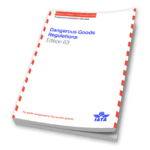
In the past two years, we have seen a drastic drop in air passenger travel due to the pandemic, but brighter days are ahead. There has recently been a steady increase in passenger numbers and the expectation is for it to continue increasing throughout the spring and summer. If you will be traveling for work, vacation, or finally visiting family and friends via air travel — there are a few tips you can follow for what type of dangerous goods you are allowed to bring on a passenger aircraft.
I would firstly like to point out that certain countries’ airport security may impose additional restrictions based on the type of dangerous goods or amounts allowable. I encourage you to always check with the airline about your goods before your travel, especially if you do not have a copy of the IATA regulations. Some dangerous goods are allowed to be carried on board in limited quantities such as cell phones and laptops with lithium batteries, alcoholic drinks, perfume, and even spare batteries. In the event of an accident with these types of dangerous goods, the crew can assist with carry-on baggage whereas in cargo they cannot. Here are a few examples of the types and amounts of dangerous goods you may carry with you on an aircraft.
- Alcoholic beverages that do not exceed 70% alcohol by volume, in a receptacle not exceeding 5 L (must still be the original retail packaging);
- A maximum of two lithium spare batteries for your electronic devices are permitted in your carry-on;
- Batteries that have watt-hour (Wh) ratings are allowed between 100 Wh and 160 Wh;
- Lithium metal batteries with a lithium metal content between 2g and 8g. These batteries must be individually protected to prevent short circuits; and
- Dry ice (solid carbon dioxide). When bringing back lobster from the Maritimes it is important to note the maximum dry ice permitted with your perishable goods must not exceed 2.5 kg per person.
In closing, it is vital for you to know that dangerous goods are not allowed in checked baggage, but it is permitted in your carry-on luggage under certain limitations. Please review IATA Table 2.3.A Provisions for Dangerous Goods Carried by Passengers or Crew for additional information on other types of products allowable as carry-on.
Photo courtesy of The Transportation Safety Board. Lithium-ion batteries in a 2018 fire on WestJet 113.
Stay up to date and sign up for our newsletter!
We have all the products, services and training you need to ensure your staff is properly trained and informed.
 IATA Publications |
 Shipping Dangerous Goods by Air Training Courses |
 UN Approved Packaging |






